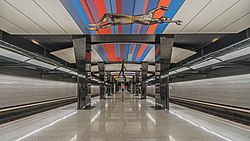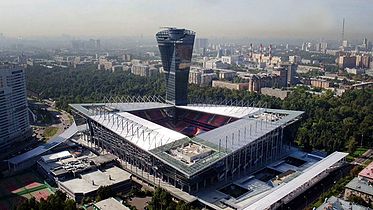Khodynka Field
|
Clockwise from top: Khodynka Field park, Houses on the Khodynka Field, |
Khodynka Field (
The field is close to several
Early history
Khodynka Field (up to the 17th century "Khodinskiy Meadow") has been known as such since the 14th century. The first mention of this name dates back to 1389, when Knyaz Dmitry Donskoy bequeathed Khodyinsky Meadow to his son Yuri Dmitrievich.
For a long time the field was undeveloped, placed it on arable land Tver coachmen settlement. At the beginning of the 17th century, the army of Tsar Vasili IV fought here against the troops of False Dmitry II.
During the reign of
In the 19th century, Khodynka was used to celebrate state occasions. In June 1883, the coronation of
Major constructions on the field included the 19th century military barracks and the Botkin Hospital, the largest in Moscow at the time of its inauguration in 1910.
Khodynka Tragedy

The field is best known as the site of a tragic accident on May 30, 1896 during the festivities of the crowning of
In the area of one town square, buffooneries, theaters, 150 buffets for distribution of gifts, and 20 pubs were built for the celebrations. Nearby to the celebration square was a field which had a ravine and many gullies. On the evening of May 17, people who had heard rumours of rich coronation gifts from the tsar (the gift was actually a bread roll, a piece of sausage, gingerbread and a mug) began to gather in anticipation.
At about 5 o'clock in the morning of the coronation day, several thousand people were already gathered on the field. A police force of 1800 men failed to maintain civil order, and in a catastrophic crush, and resulting panic to flee the scene, 1389 people were trampled to death and roughly 1300 were otherwise injured.
The negligence of the imperial authorities caused public indignation in Russia, and a number of minor officials were dismissed. However, the new Tsar did not cancel the coronation
Khodynka Airfield
The first powered flight in Russia took place at Khodynka, carried out in 1910 by
The airfield is surrounded by a variety of restricted-access facilities, including the main headquarters of
Flights into or out of the airfield apparently continued to at least 1989,[2] but the runways existed into the 2000s.
Past plans for the site included a modern air and space museum, expected to be the largest in the world upon completion.[3]
Modern developments
After the fall of the Soviet Union, the International Society for Krishna Consciousness hoped to have the largest temple in Russia to be erected there, but this did not come to pass due to vocal opposition by the Russian Orthodox Church.[4]
-
Khodynka Field park, 3D model
-
Megasport Arena, opened in 2006
-
CSKA Stadium, opened in 2016
-
Aviapark, Europe's biggest shopping mall[5]
References
- ^ "AIR-1, Ya-1, VVA-3, A.S.Yakovlev". Archived from the original on 2016-03-03. Retrieved 2006-01-12.
- ^ WarbirdsNews (2013-06-21). "Ex-Soviet Aircraft Disintegrating as Moscow's Oldest Airfield Dwindles". Warbirds News. Retrieved 2022-06-18.
- ^ "Airlines Send Old Aircraft Packing – The Top Ten Aircraft Boneyards – Part 1". Archived from the original on 2016-10-22. Retrieved 2016-10-21.
- ^ Kommersant, Krishna Followers Go on Hunger Strike against Expulsion Archived 2007-09-30 at the Wayback Machine, November 14, 2005
- ^ Walker, Shaun (28 November 2014). "Europe's biggest shopping mall opens in Moscow amid rouble crisis". The Guardian.










![Aviapark, Europe's biggest shopping mall[5]](http://upload.wikimedia.org/wikipedia/commons/thumb/c/cc/AviaPark_Moscow_01-2016_img1.jpg/374px-AviaPark_Moscow_01-2016_img1.jpg)